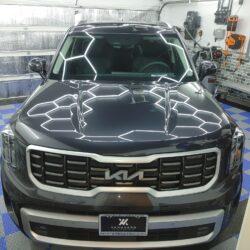Understanding the EV Interior: More Tech, More Care
The first thing to understand is that EVs and hybrids are designed around efficiency, sustainability, and technology integration. Their interiors often include:
-
Synthetic or eco-friendly materials like vegan leather or recycled fabrics
-
Touchscreens, digital dashboards, and sensors spread throughout the cabin
-
Light-colored upholstery to offset battery-related heat buildup
-
Specialized ventilation systems linked to battery cooling
Each of these features affects how you clean and protect the inside of the vehicle. For example, certain solvents that seem harmless on standard leather can quickly dull or degrade vegan leather over time. Likewise, moisture-based cleaners can interfere with capacitive touch surfaces.
Step 1: Start with a Thoughtful Vacuuming Routine
Vacuuming may seem straightforward, but it’s where many people make their first mistake—especially with electric vehicles. EVs tend to have tightly sealed cabins to improve aerodynamics and range efficiency, which means dirt, dust, and crumbs don’t easily escape once they get inside.
Pro tip: Use a soft-bristle attachment for vents, seams, and digital interfaces. Standard rigid attachments can leave micro-scratches on glossy touch panels.
Also, check the seat rails and battery housing zones. Hybrid models sometimes have floor-mounted battery compartments under the rear seats. Be gentle when vacuuming around these areas to avoid dislodging seals or wiring covers.
Step 2: Clean Surfaces Smartly—Especially Screens and Panels
Interior detailing for EVs and hybrids often revolves around one central concern: electronics. Gone are the days of wiping everything with a single all-purpose cleaner.
-
For infotainment screens, stick to microfiber cloths slightly dampened with distilled water or screen-safe solutions. Avoid alcohol or ammonia-based products, which can damage the anti-glare coatings.
-
For steering wheels and touch controls, use mild interior cleaners or dedicated electronics wipes.
-
For trim pieces, always test products on a small, hidden area first—especially if the trim is coated with a soft-touch material.
Insider tip: If you notice smudges returning quickly on touchscreens, it’s not your cleaning—it’s static buildup. Lightly buffing the screen with a dry, anti-static microfiber towel after cleaning can reduce fingerprint attraction dramatically.
Step 3: Pay Attention to Sustainable Materials
Electric and hybrid vehicles often feature innovative interior materials—some recycled, some plant-based, and others synthetic. Each has different reactions to traditional car detailing chemicals.
For example, Tesla and Polestar use vegan leather that looks great but doesn’t absorb conditioners like real leather. Instead of using leather creams, a gentle water-based protectant helps maintain the surface without leaving an oily film.
Meanwhile, hybrid models like Toyota’s Prius often have fabric interiors made from recycled fibers. These can trap dust deep within the weave. Using an upholstery extractor or steam cleaner occasionally can make a noticeable difference in texture and freshness.
Just be mindful of where the steam is directed—avoid high-heat exposure near electronic ports, seat sensors, or under-seat battery covers.
Step 4: Manage Odors the Right Way
One challenge unique to electric and hybrid interiors is odor buildup from HVAC systems. Because these vehicles operate quietly, owners often use the AC or heater more frequently, recycling the same air through the cabin filter system. Over time, that leads to musty smells or lingering humidity.
Here’s what helps:
-
Replace the cabin air filter every 6–12 months.
-
Clean the air vents using foam brushes and odor-neutralizing sprays.
-
Run the defog/defrost cycle for 5–10 minutes weekly to reduce moisture buildup inside the ducts.
If you’re doing a full interior detail, finish by running the ventilation system with an ozone generator (or an enzymatic odor neutralizer) for 15 minutes. This helps eliminate deep-seated smells without masking them with heavy fragrances.
Step 5: Don’t Forget Charging Zones and Storage Compartments
EVs and hybrids often feature extra charging ports, wireless pads, and USB-C outlets inside the cabin. These areas accumulate dust quickly, especially if food or drinks are present.
Wipe them using a dry detailing brush or compressed air rather than liquid cleaners. For the center console and cup holders, use a mild, residue-free interior cleaner followed by a silicone-free dressing to restore a clean finish.
It’s also smart to occasionally clean the trunk or cargo area, particularly in plug-in hybrids that store charging cables. Moisture and dirt from cables can eventually stain carpeting or cause mildew odors.
As explained in this guide on car detailing in Pasadena, detailing professionals often stress cleaning these overlooked areas since even a spotless cabin feels less than perfect if the storage spaces smell musty or look grimy.
Step 6: Finish with Subtle Interior Protection
Unlike older gasoline cars, EV interiors don’t need harsh protectants or strong scents to “refresh” the cabin. In fact, using silicone-heavy dressings can leave surfaces slippery or sticky—bad news if you’re dealing with touchscreen interfaces.
Instead, choose water-based, UV-protective coatings for dashboards, door panels, and trims. These provide a natural, matte finish while shielding against sun fading—especially important since many EVs feature large panoramic glass roofs.
If your car has fabric seats, a nano-based fabric guard can prevent stains without altering texture. For vegan leather, use a protectant that includes an anti-static element to keep dust at bay.
A Common Mistake to Avoid
One thing I often see—even from otherwise careful owners—is using too much product, particularly on glossy or electronic surfaces. A heavy hand with cleaner doesn’t make a car look cleaner; it often leaves streaks, residue, or buildup in tight areas.
Less is more. Spray your cloth, not the surface. Work in small sections. Give the materials time to breathe before applying protectants.
This slower, more mindful approach isn’t just safer for EV interiors—it actually makes the finish last longer.
Wrapping It Up: Detailing with Purpose
Interior detailing for electric and hybrid vehicles is as much about understanding the car’s personality as it is about cleaning it. These cars are quiet, tech-driven, and environmentally thoughtful—so your detailing process should be too.
By using gentle products, focusing on sensitive areas, and respecting the unique materials inside an EV, you’re not just making it look new—you’re preserving the innovation built into every inch of its design.
And perhaps most importantly, you’ll notice something subtle after a proper detail: your electric or hybrid car feels calmer, fresher, and more connected to the way it was meant to be experienced—clean, efficient, and effortlessly modern.




